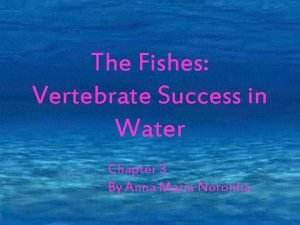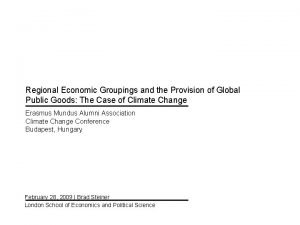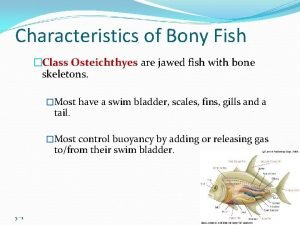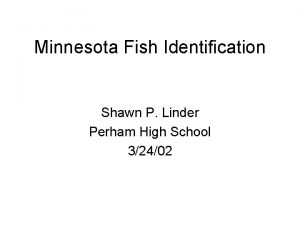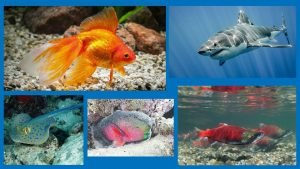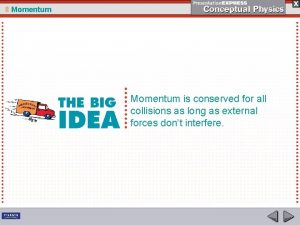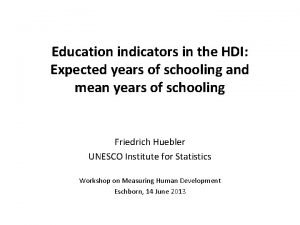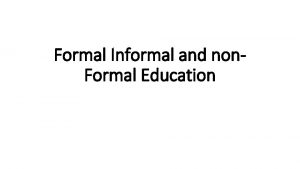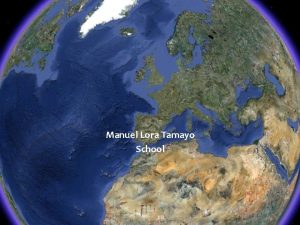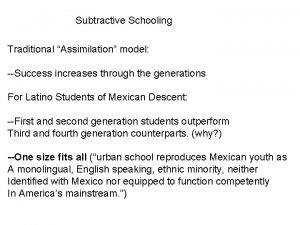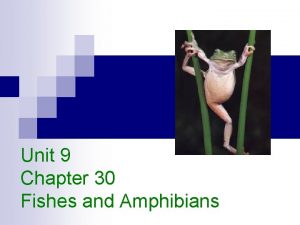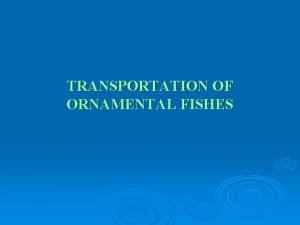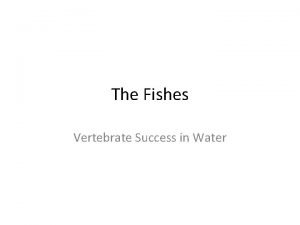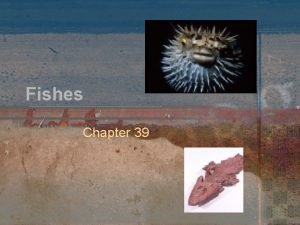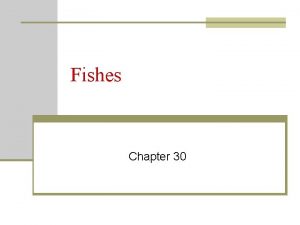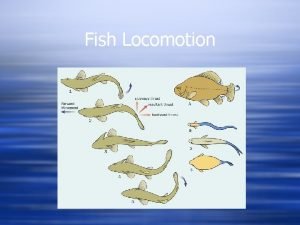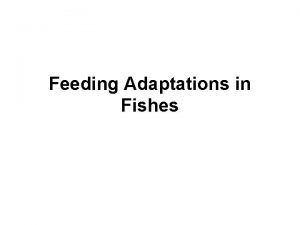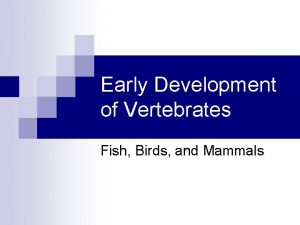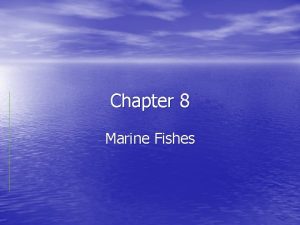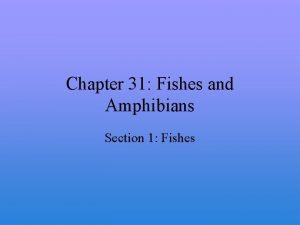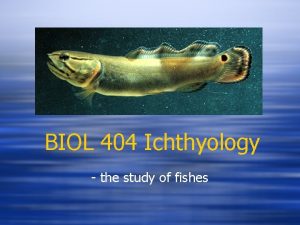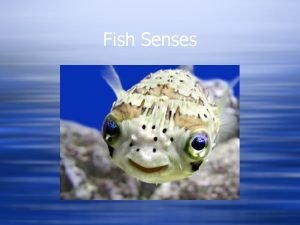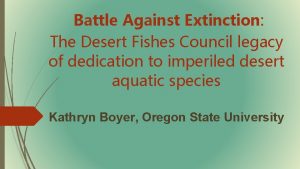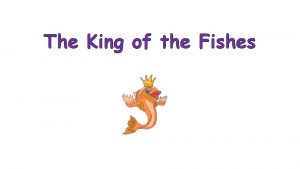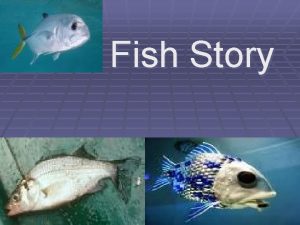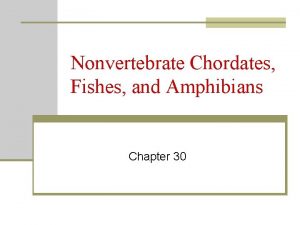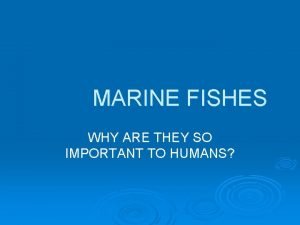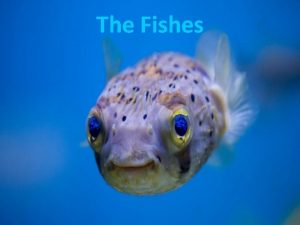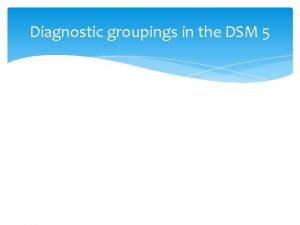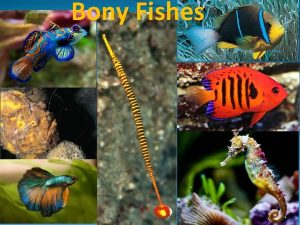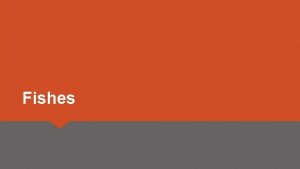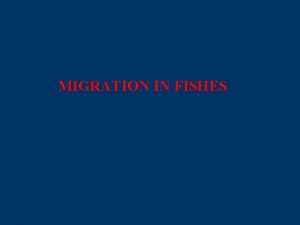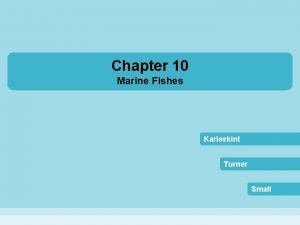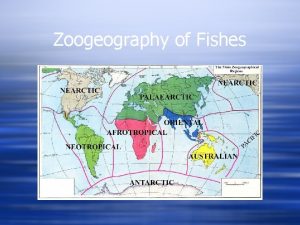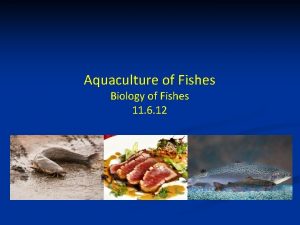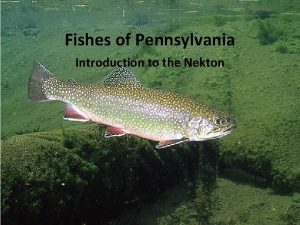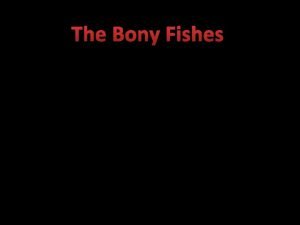Schooling Migration Groupings of fishes Schooling characteristics Fish













































- Slides: 45

Schooling & Migration Groupings of fishes Schooling characteristics Fish migrations Examples

Grouping of Fishes • Social grouping of fishes – Shoals: unorganized – Schools: organized & with polarized swimming • Groupings caused due to resources – Aggregations • Feeding • Spawning

Social Groupings

Why of Schools? • Predation avoidance – Dilution effect – Trafalgar effect – Confusion effect

Battle of Trafalgar – Admiral Nelson



Why of Schools? • Reduction of predatory success – Dilution effect – Trafalgar effect – Confusion effect • Increase feeding efficiency

Why of Aggregations? • Reduction of predatory success – Dilution effect – Trafalgar effect – Confusion effect • Increase feeding efficiency • Synchronize spawning activities


Fish Migrations Mass movement between habitats – Regular in time – According to life history • Oceanodromy (SW) • Potamodromy (FW) • Diadromy – Anadromy (to FW to breed) – Catadromy (to SW to breed) – Amphidromy (not to breed, between SE &FW)

Oceanodromy Scombridae Albacore Thunnus alalunga

Diadromy (Birth, Growth, Reprod. )

Migration Benefits & Costs • Benefits – Feeding – Avoidance of adverse conditions – Reproduction • Costs – Energy expenditure • Shad up Connecticut River: 50% energy reserves – Increased predation For migration to evolve and be maintained, benefits must exceed costs


Why Diadromy? • Rapid Growth to Adult Size – High Oceanic Productivity at high latitudes – Low Oceanic Productivity at low latitudes • Survival benefits of offspring



Tsukamoto et al. 20002




General Oncorhinchus spp. migration path

How do fish orient themselves? • • • Sun position and polarized light Geomagnetic and geoelectric fields Currents (rheotaxis) Olfaction Temperature isolines



Metamorphosis of leptocephalus larva into glass eel stage and then to early pigmented eel stage


Tsukamoto et al. 20002

Tsukamoto et al. 20002

Tsukamoto et al. 20002

Tsukamoto et al. 20002

Tagging as a way of studying migrations • Recovery tags – – Spaghetti tags Pit tags, binary code bars Recorder Tags Body markings • Paint marks • Otolith marking • Satellite Pop-Tags


Black Marlin sport fishery tagging

Estimates of Population Size • Proportional sampling • Rp = size of the range of the population (Rp), (uniform distribution) • Rs = size of sampling a region • Ns/Np = Rs/Rp. • Np = (Ns Rp)/Rs = Population Abundance No Accuracy Estimate

Estimates of Population Size • Mark & Recapture – mark – release - recapture • Np = population abundance • M = number of individuals that are marked • n = size of the second sample of organisms • R: number of marked organisms in second sample Np = (M*n)/R Accuracy Estimates Available

Binary Code Tag Pit Tag

Otolith marking


Bluefin Tuna – Archival tags Traditional tagging (need to recapture fish)

PURSE SEINE Average Annual Catches of Yellowfin tuna 1996 -98

Pop-up satellite tags

Pop-up satellite tags

Pop-up Satellite tags
 One fish two fish red fish blue fish ride
One fish two fish red fish blue fish ride One fish, two fish, blowfish, blue fish
One fish, two fish, blowfish, blue fish One fish two fish red fish lungfish
One fish two fish red fish lungfish Fish vs fishes
Fish vs fishes Color groupings that provide distinct color harmonies
Color groupings that provide distinct color harmonies Solidarity meaning
Solidarity meaning B
B Dogfish mn
Dogfish mn Anatomy of fish reproductive system
Anatomy of fish reproductive system Cartilaginous vs bony fish
Cartilaginous vs bony fish A big fish swims up and swallows a small fish at rest
A big fish swims up and swallows a small fish at rest Tilapia market form
Tilapia market form Oecd scenarios for the future of schooling
Oecd scenarios for the future of schooling Subtractive schooling definition
Subtractive schooling definition Expected years of schooling
Expected years of schooling Where did jose rizal start his formal education
Where did jose rizal start his formal education It is an intentional organized and structured
It is an intentional organized and structured Schooling active monkeys
Schooling active monkeys E schooling salesianas
E schooling salesianas Wage schooling locus
Wage schooling locus Schooling system in italy
Schooling system in italy Subtractive schooling summary
Subtractive schooling summary Role models danny boy
Role models danny boy What is amphibia
What is amphibia Conditioning of fish before transportation
Conditioning of fish before transportation The fishes vertebrate success in water
The fishes vertebrate success in water Section 39-1 review introduction to vertebrates
Section 39-1 review introduction to vertebrates Section 30-2 fishes
Section 30-2 fishes Types of fish locomotion
Types of fish locomotion Feeding adaptation
Feeding adaptation Gastrulation in fish
Gastrulation in fish Classification of marine fishes
Classification of marine fishes Chapter 31 fishes and amphibians answer key
Chapter 31 fishes and amphibians answer key Chapter 28 section 1 fishes study guide answer key
Chapter 28 section 1 fishes study guide answer key Chapter 28 section 1 fishes
Chapter 28 section 1 fishes Concept mapping chapter 28 fishes and amphibians
Concept mapping chapter 28 fishes and amphibians The study of fish
The study of fish Sharks use magnetic to seas
Sharks use magnetic to seas Battle of fishes
Battle of fishes Gordian knot allusion
Gordian knot allusion The little pink fishes swam upstream and died
The little pink fishes swam upstream and died King of fishes
King of fishes Japanese fish story
Japanese fish story Types of locomotion in fishes
Types of locomotion in fishes Chapter 30 nonvertebrate chordates fishes and amphibians
Chapter 30 nonvertebrate chordates fishes and amphibians Lung fishes
Lung fishes



